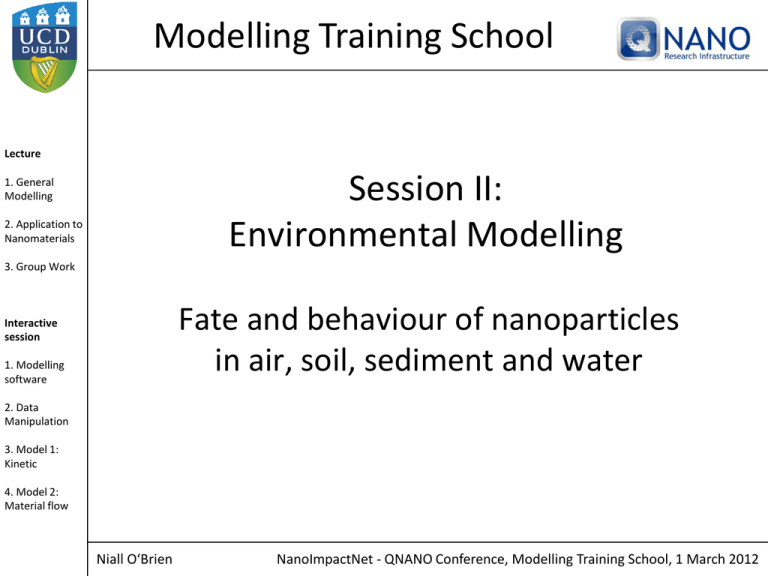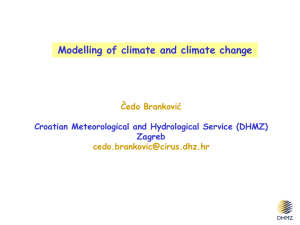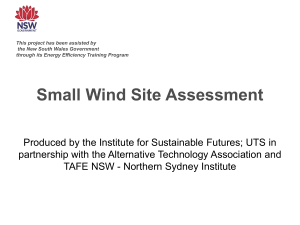Session II: Environmental Modelling
advertisement

Modelling Training School Lecture Session II: Environmental Modelling 1. General Modelling 2. Application to Nanomaterials 3. Group Work Fate and behaviour of nanoparticles in air, soil, sediment and water Interactive session 1. Modelling software 2. Data Manipulation 3. Model 1: Kinetic 4. Model 2: Material flow Niall O‘Brien NanoImpactNet - QNANO Conference, Modelling Training School, 1 March 2012 Lecture 1. General Modelling 2. Application to Nanomaterials Part 1: General Modelling 3. Group Work Interactive session 1. Modelling software 2. Data Manipulation 3. Model 1: Kinetic 4. Model 2: Material flow Niall O‘Brien NanoImpactNet - QNANO Conference, Modelling Training School, 1 March 2012 What are we modelling? Lecture THE Environment 1. General Modelling 2. Application to Nanomaterials 3. Group Work Vs Interactive session a b 1. Modelling software AN Environment 2. Data Manipulation 3. Model 1: Kinetic 4. Model 2: Material flow a. b. c. Gottschalk et al. 2010 O’Brien and Cummins 2011 Arvidsson et al. 2011 Niall O‘Brien c NanoImpactNet - QNANO Conference, Modelling Training School, 1 March 2012 Modelling parameters • Knowns Lecture 1. General Modelling 2. Application to Nanomaterials 3. Group Work – Material characteristics, environmental characteristics • Unknowns – Transformation, etc. • Simplify Interactive session – Limited pathways: all reasonably foreseeable pathways, (non-) negligible quantities 1. Modelling software – Data available? Easily measureable? 2. Data Manipulation 3. Model 1: Kinetic 4. Model 2: Material flow Niall O‘Brien NanoImpactNet - QNANO Conference, Modelling Training School, 1 March 2012 Exposure scenarios Lecture 1. General Modelling • All reasonably foreseeable scenarios 2. Application to Nanomaterials 3. Group Work • Conservative? Interactive session 1. Modelling software • Realistic? 2. Data Manipulation 3. Model 1: Kinetic 4. Model 2: Material flow Niall O‘Brien NanoImpactNet - QNANO Conference, Modelling Training School, 1 March 2012 Assumptions Lecture 1. General Modelling 2. Application to Nanomaterials 3. Group Work Interactive session 1. Modelling software 2. Data Manipulation 3. Model 1: Kinetic • Assumptions are a key element in managing uncertainty in modelling processes – Employ ‘best available data’ and logical assumptions • Consider available data • Choose best available solution • Consider actions to validate assumption (reduce uncertainty) • Simplify exposure process to pathways and processes of most influence • Formulate behavioural hypotheses, from available data, in order to predict environmental behaviour and subsequent exposure 4. Model 2: Material flow Niall O‘Brien NanoImpactNet - QNANO Conference, Modelling Training School, 1 March 2012 Variability Lecture 1. General Modelling 2. Application to Nanomaterials 3. Group Work Interactive session 1. Modelling software 2. Data Manipulation 3. Model 1: Kinetic • Variability, a effect of chance and a function of a system • Not reducible through either study or further measurement, but may be reduced by changing the physical system • May be managed within an exposure model though a number of methods: – Including data as distributions that describe a factor or function (as best measurement allows) – Modelling scenarios or systems for a number of iterations 4. Model 2: Material flow Niall O‘Brien NanoImpactNet - QNANO Conference, Modelling Training School, 1 March 2012 Uncertainty Lecture 1. General Modelling 2. Application to Nanomaterials 3. Group Work Interactive session 1. Modelling software 2. Data Manipulation 3. Model 1: Kinetic 4. Model 2: Material flow • Uncertainty, a measure of our lack of knowledge about the parameters of a system, is an essentially subjective component • Sometimes reducible through further measurement or study (or by consulting more experts) • May be managed within an exposure model though a number of methods : – Logical assessment of the information contained in available data – Assumptions and generalisations (where appropriate) to simplify the system – Use of (appropriate – again subjective) bridging data, adapted with suitable statistical methods Niall O‘Brien NanoImpactNet - QNANO Conference, Modelling Training School, 1 March 2012 Illustrating variability and uncertainty Lecture 1. General Modelling 2. Application to Nanomaterials 3. Group Work Interactive session 1. Modelling software 2. Data Manipulation 3. Model 1: Kinetic 4. Model 2: Material flow Figure 1: Binomial distribution Figure 2: Confidence distribution • Keeping variability and uncertainty separate in a model is mathematically more correct • Mixing the two together, i.e. by simulating them together, produces a reasonable estimate of total uncertainty under most conditions • But we cannot then see how much of the total uncertainty comes from variability and how much is from uncertainty Niall O‘Brien NanoImpactNet - QNANO Conference, Modelling Training School, 1 March 2012 Representation of data Lecture 1. General Modelling 2. Application to Nanomaterials 3. Group Work Interactive session 1. Modelling software 2. Data Manipulation 3. Model 1: Kinetic • The accuracy and applicability of environmental models is reliant on the quality and responsible use of available data • This data may come from many sources: – Experimental, survey, standard monitoring, historical • Much of this data may be considered a representative, random sample • There are occasions where the observed variability of this data may be applied as a probability distribution in an environmental model • Expert opinion - MCDA 4. Model 2: Material flow Niall O‘Brien NanoImpactNet - QNANO Conference, Modelling Training School, 1 March 2012 Data quality Lecture 1. General Modelling 2. Application to Nanomaterials • Are characteristics used in past/standard environmental models relevant? (not used – not relevant?) 3. Group Work Interactive session • Is parameter independent of others in the model? – Realistic scenarios 1. Modelling software 2. Data Manipulation 3. Model 1: Kinetic 4. Model 2: Material flow Niall O‘Brien NanoImpactNet - QNANO Conference, Modelling Training School, 1 March 2012 Fitting options • First order or second order Lecture 1. General Modelling 2. Application to Nanomaterials 3. Group Work Interactive session 1. Modelling software 2. Data Manipulation 3. Model 1: Kinetic 4. Model 2: Material flow – Do you need to include uncertainty? (2nd order) • Parametric or non-parametric – Parametric if: • The maths reflects the system being modelled • There is a lot of empirical evidence for a certain distribution • Lots of data, and its convenient – Non-parametric (empirical) if: • Assumption of a specific distribution is not warranted • Thus generally more conservative Niall O‘Brien NanoImpactNet - QNANO Conference, Modelling Training School, 1 March 2012 Distribution types Lecture Frequency distributions - describe variability between individuals 1. General Modelling Probability distributions - describe randomness 2. Application to Nanomaterials Uncertainty distributions - describe our uncertainty about some model parameter 3. Group Work Interactive session 1. Modelling software 2. Data Manipulation 3. Model 1: Kinetic 4. Model 2: Material flow • A frequency distribution is used as a probability distribution when we are taking a random sample from a population • We are usually uncertain about the parameters of the frequency and probability distributions, and use uncertainty distributions to describe that uncertainty. Niall O‘Brien NanoImpactNet - QNANO Conference, Modelling Training School, 1 March 2012 Building the model Lecture • Basic stages – Product X fate in WWTP • Model elements: – Fixed (Cnano1 - “nano”-fraction contained within influent) – Variable (Snano – fate/pathway in plant) – Uncertain (Rnanox – removal efficiency) 1. General Modelling 2. Application to Nanomaterials 3. Group Work Interactive session 1. Modelling software 2. Data Manipulation Cnano1 Primary treatment Secondary treatment Rnano1 Rnano2 Snano Cnano2 Overflow Rnano3 3. Model 1: Kinetic 4. Model 2: Material flow Niall O‘Brien NanoImpactNet - QNANO Conference, Modelling Training School, 1 March 2012 Common modelling errors Lecture • Calculating means instead of simulating scenarios 1. General Modelling 2. Application to Nanomaterials 3. Group Work Interactive session 1. Modelling software • Representing an uncertain variable more than once in a model • Manipulating probability distributions as if they were fixed numbers 2. Data Manipulation 3. Model 1: Kinetic 4. Model 2: Material flow Niall O‘Brien NanoImpactNet - QNANO Conference, Modelling Training School, 1 March 2012 Use of simulation • Calculate where possible Lecture 1. General Modelling 2. Application to Nanomaterials 3. Group Work Interactive session 1. Modelling software 2. Data Manipulation 3. Model 1: Kinetic – More accurate… …but difficult! • Simulate more complex problems – Level of accuracy depends on iterations – Can improve accuracy by mixing calculation and simulation – Have to simulate in second order problems • A mix of the two – Calculate the straightforward parts – Simulate the rest 4. Model 2: Material flow Niall O‘Brien NanoImpactNet - QNANO Conference, Modelling Training School, 1 March 2012 Simulation methods • Monte Carlo Lecture 1. General Modelling 2. Application to Nanomaterials 3. Group Work Interactive session 1. Modelling software 2. Data Manipulation – Random generation of values from probability distributions – Output generated values allow one to calculate approximate expected values of some quantity of interest – Various sampling methods: MC, Latin Hypercube sampling, mid-point LHS • Markov Chain Monte Carlo – Markov chains comprise a number of individuals who begin in certain allowed states of the system and who may or may not randomly change (transition) into other allowed states over time 3. Model 1: Kinetic 4. Model 2: Material flow Niall O‘Brien NanoImpactNet - QNANO Conference, Modelling Training School, 1 March 2012 Interpreting results Lecture 1. General Modelling • Run model/Simulate – Iterations Sample/Iteration 1 * = 0.38 m2/m3 2. Application to Nanomaterials 3. Group Work 6.48 mg/m3 Interactive session 1. Modelling software 2. Data Manipulation Sample/Iteration 2 . . . Sample/Iteration n 58.60 m2/g * = 0.07 m2/m3 1.45 mg/m3 48.78 m2/g * 3. Model 1: Kinetic = C m2/m3 4. Model 2: Material flow A mg/m3 Niall O‘Brien B m2/g NanoImpactNet - QNANO Conference, Modelling Training School, 1 March 2012 Interpreting results Lecture 1. General Modelling 2. Application to Nanomaterials 3. Group Work Interactive session 1. Modelling software Output Distribution 3 2 S.A. conc. (m2/m3) Sample # Conc. (mg/m ) S.A. m /g) 1 15.008005 50.508805 0.75803639 2 4.5119282 50.935773 0.22981855 3 9.6971997 55.559199 0.53876865 4 8.5119089 51.214518 0.43593331 5 2.5824819 49.620422 0.12814384 6 1.4539154 48.78201 0.070924914 7 11.782325 48.874114 0.57585068 8 6.4753148 58.594665 0.3794189 9 10.686423 49.30836 0.52692999 : : : : 10000 10.37814 54.433179 0.56491513 Regression & Correlation 2. Data Manipulation 3. Model 1: Kinetic 4. Model 2: Material flow Niall O‘Brien NanoImpactNet - QNANO Conference, Modelling Training School, 1 March 2012 Applying results • Risk assessment 1. General Modelling Risk = Exposure X Hazard – Low/no exposure → No risk – Low hazard → No risk 2. Application to Nanomaterials But… what if exposure changes → Possible future scenarios Lecture 3. Group Work Interactive session 1. Modelling software 2. Data Manipulation 3. Model 1: Kinetic 4. Model 2: Material flow • Risk management – Regulation(?) • Definitions (nano-fraction of regulated mat. significant?) • Precautionary principle – Risk-benefit analysis – Relative risk (alternatives/other “traditional” pollutants) • However, exposure models/risk assessments should not be guided by risk management expectations Niall O‘Brien NanoImpactNet - QNANO Conference, Modelling Training School, 1 March 2012 Lecture 1. General Modelling 2. Application to Nanomaterials 3. Group Work Part 2: Application to engineered nanomaterials (ENM) Interactive session 1. Modelling software 2. Data Manipulation 3. Model 1: Kinetic 4. Model 2: Material flow Niall O‘Brien NanoImpactNet - QNANO Conference, Modelling Training School, 1 March 2012 Exposure scenario Lecture Engineered nanomaterials (ENMs): What is released? – Already present in environment • Macroscale objects representing an incidental source of nps in the environment? (Glover et al. ACS Nano 2011) 1. General Modelling 2. Application to Nanomaterials – Form 3. Group Work Interactive session • Surface bound; suspended in liquid/solid; “free” • Status may (in fact definitely will) change during life cycle – Transformation/aging? 1. Modelling software • Association with other materials (e.g. colloids, natural organic matter (NOM), cations, etc.), resulting in: 2. Data Manipulation – Surface coating – Aggregation/disaggregation – Sorption of contaminants (secondary transport?) 3. Model 1: Kinetic 4. Model 2: Material flow Niall O‘Brien NanoImpactNet - QNANO Conference, Modelling Training School, 1 March 2012 Model boundaries • Defining model environment Lecture 1. General Modelling 2. Application to Nanomaterials 3. Group Work Interactive session 1. Modelling software 2. Data Manipulation 3. Model 1: Kinetic 4. Model 2: Material flow – Specific research question – Parameters of influence • ENM characteristics • Environ characteristics – Quantitative? Measurable? • Dependencies • First order • Second order • What data do we need? Is it relevant to environment/ENM life cycle stage of interest? “Carbon nanotubes should be shaken not stored” Niall O‘Brien NanoImpactNet - QNANO Conference, Modelling Training School, 1 March 2012 Model data • Populating model equations Lecture – Qualitative/Quantitative influence 1. General Modelling 2. Application to Nanomaterials 3. Group Work Interactive session 1. Modelling software 2. Data Manipulation 3. Model 1: Kinetic 4. Model 2: Material flow e.g. O’Brien and Cummins (2010) • Swapping assumptions for likelihood distributions – Subjective vs. objective • No data! Still model… – Bridging data; worst case scenario/precautionary principle • Distributions Niall O‘Brien NanoImpactNet - QNANO Conference, Modelling Training School, 1 March 2012 Quik et al. 2011 Lecture 1. General Modelling 2. Application to Nanomaterials • Different models and frameworks describing the fate and distribution of NMs have been developed: – Incorporating classical knowledge of colloid science – Applying principles used for chemical fate modelling and material flow analysis 3. Group Work Interactive session 1. Modelling software 2. Data Manipulation • Many of the model frameworks available (e.g. Gottschalk et al. (2010a,b)) may prove very valuable once more data become available to populate the probabilistic sub-models included. 3. Model 1: Kinetic 4. Model 2: Material flow Niall O‘Brien NanoImpactNet - QNANO Conference, Modelling Training School, 1 March 2012 Quik et al. 2011 Lecture 1. General Modelling 2. Application to Nanomaterials 3. Group Work Interactive session 1. Modelling software 2. Data Manipulation • However, a number of particle-specific fate equations will need to be included to ensure “nano relevance” – Among these are sedimentation, agglomeration, and dissolution; all dynamic, non-equilibrium processes – Future models must therefore focus in kinetics of fate processes – Such a kinetic model for the aquatic environment has been developed based on colloid chemistry principles (Arvidsson et al. 2011)) 3. Model 1: Kinetic Discussed in more detail later 4. Model 2: Material flow Niall O‘Brien NanoImpactNet - QNANO Conference, Modelling Training School, 1 March 2012 Quik et al. 2011 Lecture 1. General Modelling 2. Application to Nanomaterials 3. Group Work Interactive session 1. Modelling software 2. Data Manipulation • The main challenge is to use the quantitative knowledge of these processes to turn current models “fit for nano” – Can current water quality models be simply “upgraded” with nano-specific process descriptions? – If NM water column transport can be described sufficiently well by first order kinetics - not difficult – “Just” need to quantify the first order rate constants of the nano-specific processes. 3. Model 1: Kinetic 4. Model 2: Material flow Niall O‘Brien NanoImpactNet - QNANO Conference, Modelling Training School, 1 March 2012 Quik et al. 2011 Sedimentation Lecture 1. General Modelling 2. Application to Nanomaterials 3. Group Work Interactive session 1. Modelling software 2. Data Manipulation 3. Model 1: Kinetic 4. Model 2: Material flow • Inter particle collision (and aggregation) is second-order in nature – Tend to reduce to pseudo first order as the “amount” of collision capacity in natural waters is expected to remain approximately constant throughout the removal process – Removal of solids from water by sedimentation is entirely first order in relation to the concentration of suspended solids – Therefore, the overall kinetics of water-sediment transport of nanoparticles should be close to first order • “Upgrade” current exposure models of the behaviour of conventional chemicals by simply adding a first order rate constant for transport from water to sediment • Kinetic theory of particle–particle and particle–surface interactions not sufficient to quantitatively predict first order constants, but helps in making order-of-magnitude estimates Niall O‘Brien NanoImpactNet - QNANO Conference, Modelling Training School, 1 March 2012 Quik et al. 2011 Dissolution Lecture 1. General Modelling 2. Application to Nanomaterials 3. Group Work Interactive session 1. Modelling software 2. Data Manipulation 3. Model 1: Kinetic 4. Model 2: Material flow • Dissolution may, in principle, be described as a surface controlled process: dM/dt = −kSA • As the rate of dissolution is proportional to the particles' surface area (rather than mass), first order kinetics of dissolution should be expected only when area and mass are proportional – Not the case for NMs • In absence of more adequate data, Quik et al. suggest that using first order kinetics for dissolution of NMs is acceptable, BUT knowledge gap needs to be filled before dissolution can be modelled adequately • First order removal rate constant (measured experimentally) may be used to model removal of nanoparticles from water though dissolution Niall O‘Brien NanoImpactNet - QNANO Conference, Modelling Training School, 1 March 2012 Quik et al. 2011 dC/dt= E−Σk C with Σk = kadv + kvol + kdeg + ksed + kdiss Lecture 1. General Modelling 2. Application to Nanomaterials 3. Group Work Interactive session 1. Modelling software 2. Data Manipulation 3. Model 1: Kinetic 4. Model 2: Material flow • Formulated this way, the challenge of modelling is placed entirely in assigning values to the various rate constants • A weakness fo this approach is that a new removal rate needs to be measured for each individual NM • An advantage is that it provides one single approach to modelling of conventional chemical substances and NMs – This allows quantitative evaluation of the relative importance of the various removal mechanisms, as they act on substances with different properties (e.g. conventional vs. nano-chemicals) in different aquatic environments (e.g. rivers vs. lakes) Niall O‘Brien NanoImpactNet - QNANO Conference, Modelling Training School, 1 March 2012 Arvidsson et al. 2011 Lecture 1. General Modelling 2. Application to Nanomaterials 3. Group Work Interactive session 1. Modelling software 2. Data Manipulation 3. Model 1: Kinetic 4. Model 2: Material flow • Colloid chemistry kinetic equations describing particle agglomeration and sedimentation applied to the case of titanium dioxide NPs – Limited exposure assessment conducted with particle number concentration as the exposure indicator – Results indicate that sedimentation, shear flows, and settling are of less importance with regard to particle number based predicted environmental concentrations • The inflow of nanoparticles to the water compartment had a significant impact in the model • Collision efficiency (affected by natural organic matter) was shown to greatly affect model output Niall O‘Brien NanoImpactNet - QNANO Conference, Modelling Training School, 1 March 2012 Gottschalk et al. 2010 • A probabilistic method to compute PECs by means of a stochastic stationary substance/material flow modelling. Lecture 1. General Modelling 2. Application to Nanomaterials 3. Group Work Interactive session – Carried out in R – Implemented and validated with ENP TiO2 data in Switzerland • Uncertainties concerning model parameters (e.g. transfer and partitioning coefficients, emission factors) and exposure causal mechanisms (e.g. level of compound production and application) addressed through: – Sensitivity and uncertainty analysis 1. Modelling software – Monte Carlo simulation 2. Data Manipulation – Markov Chain Monte Carlo modelling 3. Model 1: Kinetic 4. Model 2: Material flow • Model is basically applicable to any substance with a lack of data concerning environmental fate, exposure, emission and transmission characteristics. Niall O‘Brien NanoImpactNet - QNANO Conference, Modelling Training School, 1 March 2012 Gottschalk et al. 2010 Lecture 1. General Modelling 2. Application to Nanomaterials 3. Group Work Interactive session 1. Modelling software 2. Data Manipulation 3. Model 1: Kinetic 4. Model 2: Material flow Niall O‘Brien NanoImpactNet - QNANO Conference, Modelling Training School, 1 March 2012 Group work Lecture 1. General Modelling 2. Application to Nanomaterials 3 products – 3 ENM forms a. Suspended in liquid: Paint/coating b. Suspended in solids: CNT filler c. Surface bound: Antibacterial surface coating 3. Group Work Interactive session 1. 2. Identify 3 critical exposure points Identify 3 key questions relating to ENM fate 3. Discuss strategies/answers to questions posed – Formation of models/model parameters 1. Modelling software 2. Data Manipulation 3. Model 1: Kinetic 4. Model 2: Material flow Niall O‘Brien NanoImpactNet - QNANO Conference, Modelling Training School, 1 March 2012 References A short selection of recent studies relating to ENM environmental fate, behaviour or modelling and modelling reference sources. This area is constantly expanding so it is important check for new studies/data to keep models relevant and applicable. Lecture 1. General Modelling • 2. Application to Nanomaterials 3. Group Work Interactive session 1. Modelling software • • • • • 2. Data Manipulation 3. Model 1: Kinetic 4. Model 2: Material flow • • • • Arvidsson, R et al. Challenges in Exposure Modeling of Nanoparticles in Aquatic Environments. Hum Ecol Risk Assess. 17, 245–262 (2011). Blaser, SA et al. Estimation of cumulative aquatic exposure and risk due to silver: Contribution of nanofunctionalized plastics and textiles. Sci Total Environ. 390, 396-409 (2008). Christian, P et al. Nanoparticles: structure, properties, preparation and behaviour in environmental media. Ecotoxicology. 17, 326–343 (2008). Gottschalk, F et al. 2010. Probabilistic material flow modeling for assessing the environmental exposure to compounds: Methodology and an application to engineered nano-TiO2 particles. Environmental Modelling & Software. 25, 320–332 (2010). Mueller N, Nowack B. Exposure modeling of engineered nanoparticles in the environment. Environ Sci Technol. 42, 4447–4453 (2009). O’Brien N, Cummins E. A risk assessment framework for assessing metallic nanomaterials of environmental concern: Aquatic exposure and behaviour. Risk Analysis, DOI: 10.1111/j.1539-6924.2010.01540.x Tervonen, T et al. Risk-based classification system of nanomaterials. J. Nanopart. Res. 11, 757–766 (2009). Quik, J et al. How to assess exposure of aquatic organisms to manufacured nanoparticles? Environ Int. 37, 1066-1077 (2011). Vose, David. Risk Analysis: a quantitative guide (3rd Edition) ISBN 978-0-470-51284-5 Vose, David. Fitting distributions to data – and why you’re probably doing it wrong. White paper. www.vosesoftware.com Niall O‘Brien NanoImpactNet - QNANO Conference, Modelling Training School, 1 March 2012 Lecture 1. General Modelling 2. Application to Nanomaterials Interactive Session 3. Group Work Interactive session 1. Modelling software 2. Data Manipulation 3. Model 1: Kinetic 4. Model 2: Material flow Niall O‘Brien NanoImpactNet - QNANO Conference, Modelling Training School, 1 March 2012 Modelling software Lecture 1. General Modelling 2. Application to Nanomaterials 3. Group Work Interactive session 1. Modelling software 2. Data Manipulation 3. Model 1: Kinetic 4. Model 2: Material flow Software that allows us to represent the data at hand and recreate desired scenarios Spreadsheets (and VBA) • Number of add-on statistical programs/packages: – @Risk, Crystal Ball, ModelRisk • Easy to pick up • Demonstrate the handling of variable or uncertain data • But, scale badly and limited to 2/3 dimensions – Cannot easily handle the modelling of dynamic systems – Multidimensional problems are more suited to modelling environments such as C++ – Matlab, R, Mathematica and Maple have powerful built-in modelling capabilities that can handle many dimensions Niall O‘Brien NanoImpactNet - QNANO Conference, Modelling Training School, 1 March 2012 Representing the model system Influence diagrams Lecture 1. General Modelling 2. Application to Nanomaterials 3. Group Work Interactive session • A network that shows the relationship between variables • Submodels (lower levels of interaction) within main model • Variables (nodes) represented as graphical objects connected together with arrows (arcs) that show the direction of interaction • Visual, but mathematics and data behind the model are hard to get to Cw 1. Modelling software 2. Data Manipulation 3. Model 1: Kinetic 4. Model 2: Material flow E (kadv kvol kdeg k sed ).V Volatilisation to air (Kvol) Degradation (Kdeg) Steady-state surface water concentration (Cw) Emission to water body (E) Xsc Xsa Xpps Xagg Niall O‘Brien Advection out of system (Kadv) Sedimentation (Ksed) Kp Water body volume (V) Wnom WpH NanoImpactNet - QNANO Conference, Modelling Training School, 1 March 2012 Representing the model system Event trees Lecture 1. General Modelling 2. Application to Nanomaterials 3. Group Work • Describe a sequence of probalistic events, their probabilities and impacts • Event trees built out of nodes and arcs • Mathematics to combine the probabilities is (relatively) simple and diagram helps ensure the necessary discipline • Lends itself well to probalistic mass flow balancing Interactive session Snapshot from Gottschalk et al. 2010 – Mass flows between environmental compartments for nano-TiO2 1. Modelling software 2. Data Manipulation 3. Model 1: Kinetic 4. Model 2: Material flow Niall O‘Brien NanoImpactNet - QNANO Conference, Modelling Training School, 1 March 2012 Representing the model system Discrete event simulation (DES) Lecture 1. General Modelling 2. Application to Nanomaterials 3. Group Work Interactive session 1. Modelling software • DES differs from Monte Carlo simulation in that it models the evolution of a (usually stochastic) system over time • Equations are defined for each model element – its changes, movement and interaction with other model elements • The system is stepped through small time increments and tracks each element throughout • Allows the modelling of extremely complicated systems by defining how elements interact and letting the model simulate what might happen 2. Data Manipulation 3. Model 1: Kinetic 4. Model 2: Material flow Niall O‘Brien NanoImpactNet - QNANO Conference, Modelling Training School, 1 March 2012 Data manipulation • Applying distributions to data Lecture 1. General Modelling 2. Application to Nanomaterials 3. Group Work – Example 1: ENM WWTP removal efficiencies • Data quality check • Parametric (model-based) or non-parametric (empirical) distribution? • First or second order distribution? – Example 2: Ca2+ concentrations in Irish surface waters Interactive session 1. Modelling software 2. Data Manipulation 3. Model 1: Kinetic 4. Model 2: Material flow • Applying a correlation to two variables – Example: pH and Ca2+ • Rank order correlation & Copulas • Correlation coefficient • Guidelines Niall O‘Brien NanoImpactNet - QNANO Conference, Modelling Training School, 1 March 2012 Material flow analysis Example: Water partitioning Min Lecture 1. General Modelling 2. Application to Nanomaterials * Kdeg Ksed 3. Group Work Kadv Madv Surface water (Mwat) Sediment (Msed) Interactive session 1. Modelling software 2. Data Manipulation 3. Model 1: Kinetic 4. Model 2: Material flow • Limited model environment – Defined parameters – Defined influences – Handling input data – Uncertainty and variability – Interpreting results Niall O‘Brien NanoImpactNet - QNANO Conference, Modelling Training School, 1 March 2012






